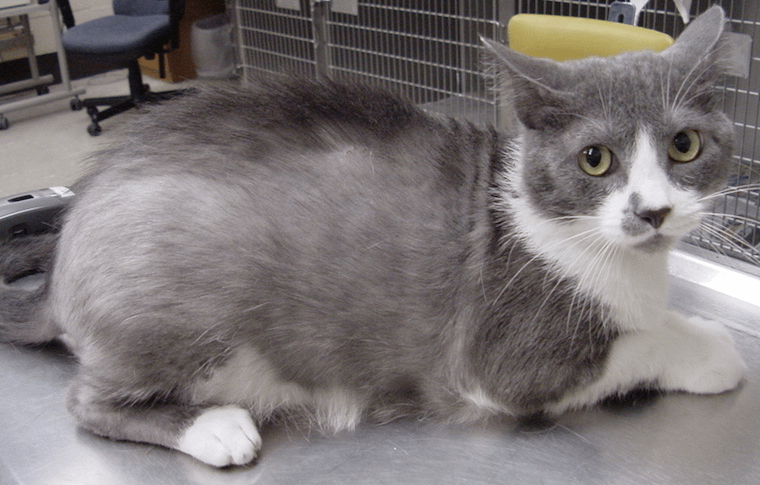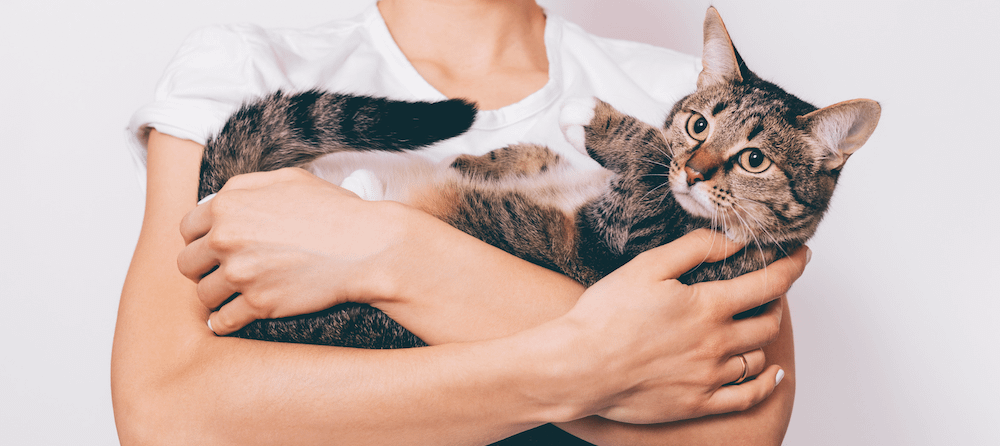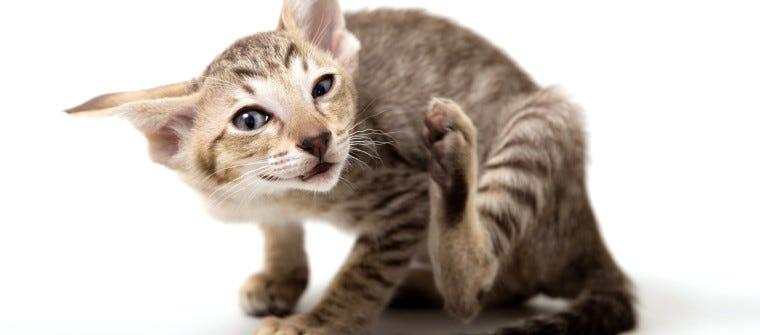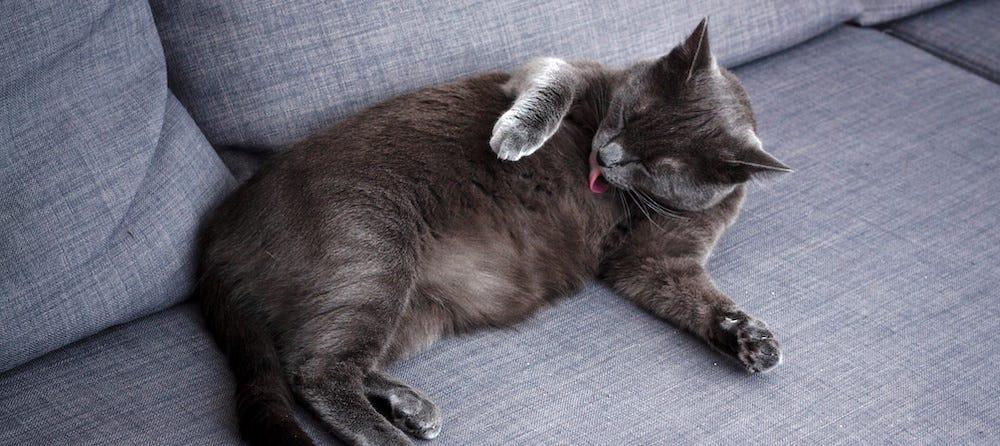Hair shedding is normal for both cats and humans, but what if the hair just keeps coming out? Is your cat losing hair to the point of thinning fur or even baldness in some spots? It’s important to recognize the difference between your cat’s typical shedding and what may be abnormal hair loss. Cat hair loss, also known as alopecia in cats, can have several causes—most of which are easily treatable.
Is it shedding or hair loss?
As the pet parent, you are the first line of defense in noticing something is off with your cat's hair. Cats do tend to shed a lot of hair, but this shedding is typically consistent throughout their coat and should not raise concern. Many adult cats—regardless of breed—experience thinning fur on the strip of skin between their ears and eyes. Hair loss can range from small, limited areas of the body up to being nearly bald. Knowing what is normal for your cat is important; if they deviate from that, you should schedule an appointment with your veterinarian.
Classifications of cat hair loss
“How long has your cat been missing hair here?” is an example of an excellent closed-ended question that your veterinary staff may ask to investigate. Alopecia can be congenital, meaning the hair has been missing most of the cat’s life, or it can be acquired, meaning that the cat was able to produce hair there before and now it’s gone. It may be easy to assume that if the hair loss is congenital, it must be hereditary, but that is not always the case. But, you can assume that if the hair was normal at some point and is not now, the hair loss is indeed acquired.
Additionally, hair loss can be classified as inflammatory or non-inflammatory. Inflammatory-acquired alopecia is the result of a disease process or injury that causes pain, swelling, discomfort, etc. Non-inflammatory hair loss is typically not painful and tends to be caused by issues outside of the cat’s control such as hormone imbalances and luck-of-the-draw genetic selection. Inflammatory hair loss is most common and often presents with a kitty who won’t stop licking, but can’t tell you why.
Common causes of cat hair loss
Cats are clean animals. It is common practice for them to groom themselves regularly. If you notice that your cat is incessantly licking, biting, or scratching at themselves, you should set up an appointment with your veterinarian. If you don’t notice your cat overgrooming, but you see hair missing, set that appointment. The excessively licking can cause hair loss, but what caused the licking? And if they aren’t licking and they are missing hair, then what is really going on? Parasitism, stress, poor nutrition, allergies, masses, injuries, and infection are a few reasons that a cat may experience feline alopecia. Using the information that you provide and the physical exam, the vet will recommend diagnostics to find a treatment.
Nutrition
A diet that meets all of your cat’s needs will also support the management of a healthy hair coat. Pet food companies do a fantastic job of marketing their products, but not all diets are created equal. A fortified cat diet is going to cater to the fact that cats are carnivores and require many other vitamins, minerals, and nutrients. If you notice that your cat’s hair coat is looking dull, thin, and possibly patchy, a good first step to check their diet. In evaluating their diet, you should look for an AAFCO nutritional guarantee. AAFCO, the Association of American Feed Control Officials, has a subcommittee called the Feline Nutrition Experts that established the basic minimum nutritional requirements for cat food. If a food bag or can has an AAFCO statement, then it contains everything your cat needs to be healthy, thrive, and produce a healthy hair coat.
Flea allergy dermatitis
In some cats, the biting of the flea itches enough to make them overgroom to the point of hair loss. In other cats, they may have an allergy to the flea’s saliva that starts the process that leads to hair loss. Preventative care is essential. While most of this care refers to vaccines, dewormers, and blood work, it also includes heartworm, flea, and tick prevention. Commonly affected areas are the rump (base of the tail), head, neck, and often a pattern called Feline Acquired Symmetrical Alopecia; if you split your cat in half from nose to tail, the hair loss is nearly identical on the left and right side.

“Not seeing fleas does not mean that your cat does not have them. Fleas are sneaky, agile parasites and they jump. They can be extremely irritating and often cause skin problems. Flea prevention is a fantastic first step in trying to determine the cause of hair loss; I recommend Revolution Plus.” - Laria Herod, DVM
Aside from looking for an active flea infestation, your veterinarian may look for flea dirt as evidence that fleas have been on your cat. If this cannot be found, they may perform some blood work (a complete blood cell count, usually) to evaluate your cat's eosinophil levels: this value is often elevated in animals experiencing parasitism. Either way, a trial of flea prevention is the next step.
Allergies in Cats
Flea allergies are actually not that common, but your cat may also have other allergies—dust, pollen, food, insect bites, or medications, to name a few—that cause itchiness, prompting them to overgroom in an attempt to ease their symptoms.
Food Allergies
Food allergies are usually to the protein in the diet. While allergy testing is available, there are very mixed reviews on how effective the tests are, unless it is being performed at the dermatologist. Many veterinarians will pursue other treatment options before recommending allergy testing or a food trial. A food trial is removing all of the protein sources that your cat has been fed up to that point from their diet and replacing it with a protein it has never been exposed to. While food trials can be helpful diagnostic tools, they are hard because the cat can only have their special diet for 8 to 12 weeks to determine if they’re effective. If so, then this is the diet they need to stay on to address the hair loss and accompanying symptoms.
Environmental Allergies
Cats can also be allergic to things in their environment, just like humans. This is called atopic dermatitis or atopy. The most prominent reaction to atopy is severe itching, which can of course lead to hair loss. Addressing this is a little more complicated as seasonal changes often affect the severity of the cat’s symptoms. Your vet may be able to prescribe medications such as steroids, antihistamines, immunosuppressive drugs, allergy shots, or even a food trial. Unfortunately, allergies don’t typically have a cure, so your cat will continuously need treatment for their outbreaks throughout their lives. Medications in addition to some lifestyle changes are key. Providing them with a cleaner living environment (including a self-cleaning litter box) can be extremely helpful.
Cat mange
Less commonly, hair loss can be a symptom of mange in cats. Also called feline scabies, it is caused by a mite called Notoedres cati; it is contagious from cat to cat. Often presenting as hair loss and crusty, flaky skin on the head, ears, and neck, if not caught quickly, it can spread to the entire body. It is very itchy and makes cats uncomfortable.
Another type of mite that can affect cats is Demodex. This mite does not normally affect healthy cats as it can be a normal inhabitant of their skin. Cats with a weakened immune system due to some other disease process are more susceptible to hair loss caused by Demodicosis. Other symptoms outside of hair loss include crusty skin and fluid-filled sores. Much like its fellow mite, it can be limited to the head and neck or spread all over the body.
Mites are diagnosed by performing a skin scrape: your veterinarian will use this to look for mites under a microscope. If found (or sometimes pending your vet’s intuition) treatment options may include topically applied medications or injectable medications. Bathing or dipping your cat in lime-sulfur on a schedule specified by your veterinarian may do the trick as well. These diseases can be frustrating because sometimes the mite cannot be found on the skin scrape; your vet may need to treat first and make the official diagnosis if the treatment works. Thankfully, infested cats respond to treatment quickly.
If your cat has other allergies, your vet may be able to prescribe medication. Otherwise, you may need to make some lifestyle changes, such as varying your cat’s food and providing them with a cleaner living environment.
Cat overgrooming related to anxiety and stress
Is your cat pulling their hair out? Sometimes behavioral issues in cats lead to hair loss. If cats are highly stressed or anxious, they may overgroom themselves to the point of baldness, especially in easy-to-reach spots like the belly, sides, and legs. You may be able to ease your cat’s overgrooming by determining the cause of their stress. Has there been a recent change in their living environment or lifestyle? Might they have separation anxiety while you’re out of the house? If all else fails, talk to your vet about prescription anti-anxiety medications. Never give your cat human anti-anxiety medication. There are also over-the-counter supplements that can be beneficial like Purina ProPlan’s Calming Care supplements or adding a cat pheromone diffuser like Feliway.
Skin infections
Alopecia in cats can also be attributed to skin infections: these infections can be caused by bacteria or fungi like yeast or ringworm. These skin infections are often a result of some other insult to the skin such as overgrooming, parasitism, wounds, and separate disease processes. Once the protective barrier of the skin is disrupted, the possibility for infection increases and the severity of the infection dictates how much hair is lost. In addition to the loss of hair, a whole host of skin abnormalities may be appreciated. Here are a few examples:
- Itchy, scaly, or dry skin
- Red patches on the skin or darker skin coloration
- Swelling or bumps of the skin
- Dandruff
- Excessive shedding
Your veterinarian will recommend skin diagnostics to determine the nature of the infection and prescribe oral or topical medications like shampoos, skin dips, or ointments to resolve it. In addition to antibiotics or antifungals, your veterinarian may prescribe medications to address the pain and inflammation that often accompanies skin infections.
Hormonal imbalances
Hormonal changes are another cause of hair loss. Pregnancy and lactation often cause temporary hair loss; but there are other hormone changes that can have more lingering effects unless treated with appropriate medications.
Hyperthyroidism, or an overactive thyroid, is a common endocrine disease that contributes to a poor hair coat that sheds excessively, gets matted, and is generally unkempt. Very rarely cats may develop Cushing’s disease; this is an overproduction of the steroid cortisol causing cats to have extremely fragile, thin skin, also known as feline fragile skin syndrome. Patchy hair loss and an unkempt coat are common manifestations of Cushing’s due to the fragility of the skin. In both of these endocrine diseases, treatment is aimed at correcting the imbalance to resolve the unhealthy skin conditions (and other specified symptoms) that leave cats prone to hair loss and skin infections.
Pain
Because cats are so resilient and do an excellent job of hiding their discomfort, it can be difficult to quantify their pain. Rather than showing physical signs of being uncomfortable or crying out, cats may lick painful areas in an attempt to ease the discomfort and the licking can be to excess and cause hair to fall out. Much too often, people write off abnormalities in cats as “oh they’re getting older and slowing down.” Because of this and a previous lack of a variety of treatment options, arthritis in cats is chronically undertreated.
If you suspect your cat is painful or injured, take them to the vet as soon as possible. We now have a wide range of options when it comes to treating arthritis in cats; work with your veterinarian on a plan that best suits your cat.
Certain breeds are more prone to hair loss
Some hairless cat breeds actually start out with fur, like the Donskoy, and then lose their hair over time. Other breeds, such as the Lykoi, Minksin, and Peterbald, are often partially hairless.
Furthermore, certain purebreds may carry genes that are more likely to cause alopecia; for instance, Siamese cats are more prone to hair loss on the outside of the ears.
Will my cat’s hair grow back?
Fortunately, in most cases your cat’s hair will grow back—provided they have been properly diagnosed and treated. There is a chance that hair will not regrow if the hair follicles in the affected area are irreversibly damaged. If this is the case, that missing hair should not have a long-lasting impact on your cat: they will adjust to their new normal.
Sources:
- Alopecia in Animals
- Hair Loss (Alopecia) in Cats
- A Thin Line: Normal Shedding Vs. Feline Alopecia
- Psychogenic Alopecia in Cats
- Mite Infestation (Mange, Acariasis, Scabies) of Cats
- Allergies in Cats
- Feline Skin Diseases
- Feeding Your Cat








